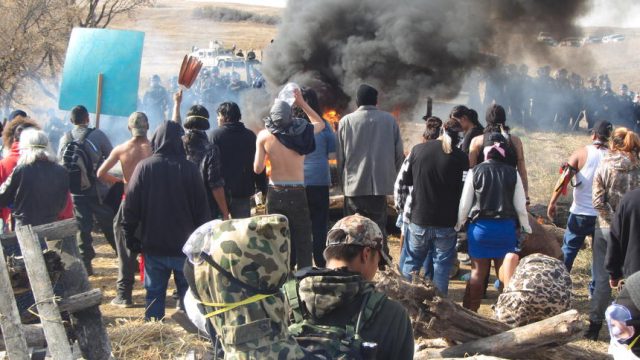North Dakota Journalist Recounts Intimidation, Censorship at Hands of #NoDAPL Protesters

The Williston Herald has published an eye-opening story about the protests against the Dakota Access Pipeline which provides a perspective on the #NoDAPL movement that has gone little reported. Which is surprising because what reporter Renée Jean recounts is intimidation and censorship aimed specifically at people who report the news.
According to her report, journalists working at the camp were tightly controlled. If they asked questions protest organizers didn’t like they’d be surrounded by “security,” and perhaps their cameras or equipment would be seized and their work destroyed:
We were told to wear our passes at all times in a prominent spot. We could not take pictures of the kitchens and the Red Warrior camps were off-limits. We were told they are just “secretive.” In actuality, a member of the tribe and some of the other protesters admitted that this is where some of the more youthful members, who have been arguing for more extreme measures, reside, for which camp elders had been chastising them. Keeping their area off-limits helps keep journalists away from that aspect of the story.
We were not to take photographs where people would be recognizable without asking first, nor were we to take pictures of people wearing Native American regalia or engaging in private prayer or ceremonies without explicit permission. Even if we were going on an action that might be in a public place and involve interactions with public officials, we could only take photos if given permission by the action leader, or else might lose our pass, as well as, perhaps, all our work.
If we behaved like “Paparazzi” and peppered people with too many uncomfortable questions, we were again inviting security to come surround us, take our equipment and delete all of our work. That meant we couldn’t really press for answers to tough questions, and we had to be careful who we asked such questions and where, because we could be overheard by someone who might call security.
According to Jean, reporters wishing to work the protest have to check in at a media tent at the protest site where their press credentials and drivers license were turned over to be copied and their pictures were taken for the protest movement’s “database.”
Which sounds downright Orwellian. And there is no other word to describe the protest movements policy on photography other than censorship.
“We tended to be denied photos that might not make the camp look great to the rest of the world,” Jean writes.
What’s remarkable is that these severe restrictions on media haven’t, to my knowledge, been reported anywhere else despite widespread and intense local and national coverage of the protests. Why have so many reporters been willing to accept these restrictions without, at the very least, reporting on their existence?
And then there’s this interaction Jean had with some out of state reporters who clearly took a side in the debate over the pipeline:
Waiting in line with other journalists at Media Hill to be processed in, there was time for a little chit-chat. Three from New York wanted to know where the Dakota Access pipeline was to be laid in relation to the camp. I pointed out the electrical towers visible from where we were standing and said that is a utility corridor. In addition to the electrical line, there’s a 1982 gas line laid there, I added.
She wanted to know about the state’s permitting process, so I told her that North Dakota requires companies to choose the least impactful route for a pipeline, and explained that since a line had already been placed there, the Corps had told Dakota Access to use that.
She rolled her eyes and dismissed that as “company propaganda.”
Meanwhile, one of her companions chimed in to say we should really just keep fossil fuels in the ground.
“We should have made this transition a long time ago,” she said. “If our government cared about us, they would have already done it.”
I meekly asked how we’d get to the camp in that case. Not really to be a smart aleck, but it just popped out. I was genuinely curious to know.
“In our electric cars,” she said.
Wow.
Jean does mention that law enforcement and the Dakota Access Pipeline company also had some restrictions for the media. For instance, law enforcement was sensitive about showing the faces of individual officers, or revealing their identities, which makes sense given reports we’ve had about individual law enforcement officers getting harassed at their homes and on social media by protesters and/or their supporters. Back in August I wrote a post about ND Highway Patrol officers removing their name badges to avoid this (they kept their badge numbers visible).
But nothing Jean attributes to the pipeline company or law enforcement approaches the restrictions and intimidation perpetrated by the protesters themselves.
Read Jean’s whole story. It’s worth your time. And, again, remember that even though these protests have been on-going for months, this is the first time anyone in the media has taken the time to report how the media is being treated at the protest camps.




